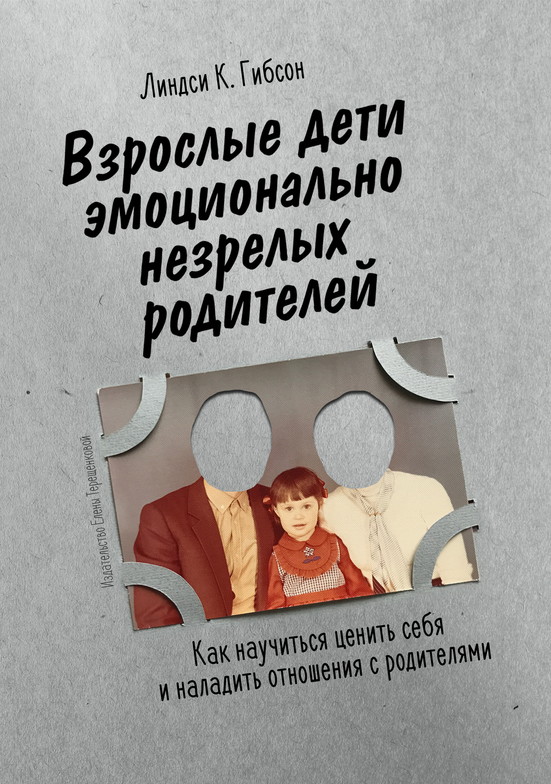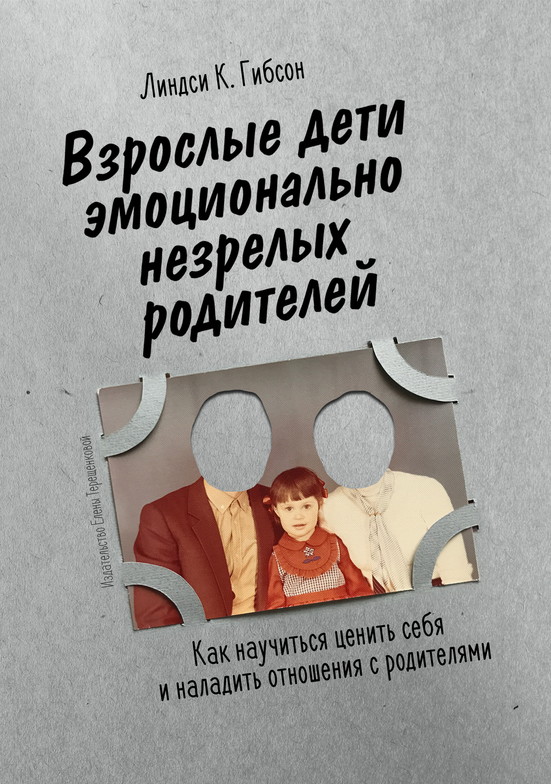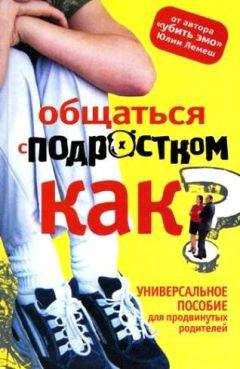свою семью, вы, скорее всего, начнете совершенно по-новому относиться к жизни. Избавившись от сомнений и раздражения, вызванных поведением эмоционально незрелых людей, вы почувствуете, что ваша жизнь стала легче и проще. Я надеюсь, что эта книга не только помогла вам лучше понять себя и своих близких, но и подарила вам облегчение и свободу жить, руководствуясь своими настоящими мыслями и чувствами, отказавшись от устаревших семейных моделей.
Когда я смотрю на моих клиентов, которые открывают свои истинные чувства в первый раз и могут наконец увидеть эмоциональную незрелость других людей, их лица излучают удивление и покой. Я без преувеличения могу назвать это просветлением. Никто из них не согласился бы отказаться от этого нового знания. Каждая частица правды, с которой они сталкиваются в своей душе, возвращает их к себе. Несмотря на все сожаления, их охватывает ни с чем несравнимое ощущение целостности. Они чувствуют, что это новая точка отсчета в их жизни.
И это так и есть. Люди, занимающиеся самопознанием и своим эмоциональным развитием, получают шанс на вторую жизнь – жизнь, которую они даже не могли себе представить, пока находились во власти старых семейных ролей и фантазий. Вы и правда можете начать все сначала, если осознаете, кем вы являетесь и что происходит в вашей жизни. Как сказал один человек, теперь он точно знает, кто он, и если другие не собираются меняться, он может это сделать.
Нет причины, мешающей вам начать жить счастливо прямо сейчас. Я даже думаю, что, если вы подарите себе счастливую жизнь сейчас, став осознанным взрослым, вы будете ценить ее больше, чем если бы она была у вас с самого начала. Осознанно присутствовать при рождении нового себя – это невероятное чувство. Скольким людям удается стать свидетелем появления на свет человека, которым они были задуманы? Скольким людям удается прожить две жизни?
Ну что, возможность прожить две жизни стоит той боли, через которую вам пришлось пройти? Вы рады, что выбрали путь осознанности?
Да? Я тоже.
Список литературы
Ainsworth, M. 1967. Infancy in Uganda: Infant Care and the Growth of Love. Baltimore, MD: Johns Hopkins Press.
Ainsworth, M., S. Bell, and D. Stayton. 1971. “Individual Differences in Strange-Situation Behaviour of One-Year-Olds.” In The Origins of Human Social Relations, edited by H. R. Schaffer. New York: Academic Press.
Ainsworth, M., S. Bell, and D. Stayton. 1974. “Infant-Mother Attachment and Social Development: ‘Socialization’ as a Product of Reciprocal Responsiveness to Signals.” In The Integration of a Child into a Social World, edited by M. Richards. New York: Cambridge University Press.
Bowen, M. 1978. Family Therapy in Clinical Practice. New York: Rowman and Littlefield.
Conradt, E., J. Measelle, and J. Ablow. 2013. “Poverty, Problem Behavior, and Promise: Differential Susceptibility Among Infants Reared in Poverty.” Psychological Science 24(3): 235-242.
Dabrowski, K. 1972. Psychoneurosis Is Not an Illness. London: Gryf.
Ezriel, H. 1952. “Notes on Psychoanalytic Group Therapy: II. Interpretation and Research.” Psychiatry 15(2): 119-126.
Firestone, R., L. Firestone, and J. Catlett. 2002. Conquer Your Critical Inner Voice. Oakland, CA: New Harbinger.
Fonagy, P., and M. Target. 2008. “Attachment, Trauma, and Psychoanalysis: Where Psychoanalysis Meets Neuroscience.” In Mind to Mind: Infant Research, Neuroscience, and Psychoanalysis, edited by E. Jurist, A. Slade, and S. Bergner. New York: Other Press.
Fosha, D. 2000. The Transforming Power of Affect: A Model for Accelerated Change. New York: Basic Books.
Fraad, H. 2008. “Toiling in the Field of Emotion.” Journal of Psychohistory, 35(3): 270-286.
Gibson, L. 2000. Who You Were Meant to Be: A Guide to Finding or Recovering Your Life’s Purpose. Far Hills, NJ: New Horizon Press.
Gottman, J. 1999. The Seven Principles for Making Marriage Work. New York: Three Rivers Press.
Grossmann, K. E., K. Grossmann, and A. Schwan. 1986. “Capturing the Wider View of Attachment: A Re-Analysis of Ainsworth’s Strange Situation.” In Measuring Emotions in Infants and Children, vol. 2, edited by C. Izard and P. Read. New York: Cambridge University Press.
Hatfield, E., R. L. Rapson, and Y. L. Le. 2009. “Emotional Contagion and Empathy.” In The Social Neuroscience of Empathy, edited by J. Decety and W. Ickes. Boston: MIT Press.
Kohut, H. 1985. Self-Psychology and the Humanities. New York: W. W. Norton.
Libby, E. W. 2010. The Favorite Child: How a Favorite Impacts Every Family Member for Life. Amherst, NY: Prometheus Books.
Main, M., N. Kaplan, and J. Cassidy. 1985. “Security in Infancy, Childhood, and Adulthood: A Move to the Level of Representation.” In Growing Points of Attachment Theory and Research, edited by I. Bretherton and E. Waters. Monographs of the Society for Research in Child Development 50: 66-104.
McCullough, L., N. Kuhn, S. Andrews, A. Kaplan, J. Wolf, and C. Hurley. 2003. Treating Affect Phobia: A Manual for Short-Term Dynamic Psychotherapy. New York: Guilford.
McGilchrist, I. 2009. The Master and His Emissary: The Divided Brain and the Making of the Western World. New Haven, CT: Yale University Press.
Porges, S. 2011. The Polyvagal Theory: Neurophysiological Foundations of Emotions, Attachment, Communication, and Self-Regulation. New York: W. W. Norton.
Siebert, A. 1996. The Survivor Personality. New York: Penguin Putnam.
Siegel, D. 2009. “Emotion as Integration.” In The Healing Power of Emotion: Affective Neuroscience, Development, and Clinical Practice, edited by D. Fosha, D. Siegel, and M. Solomon. New York: W. W. Norton.
Tronick, E., L. B. Adamson, and T. B. Brazelton. 1975. “Infant Emotions in Normal and Perturbed Interactions.” Paper presented at the biennial meeting of the Society for Research in Child Development, Denver, CO, April.
Vaillant, G. 2000. “Adaptive Mental Mechanisms: Their Role in a Positive Psychology.” American Psychologist 55(1): 89-98.
Young, J., and J. Klosko. 1993. Reinventing Your Life: How to Break Free from Negative Life Patterns. New York: Dutton.
Боулби Д. Создание и разрушение





